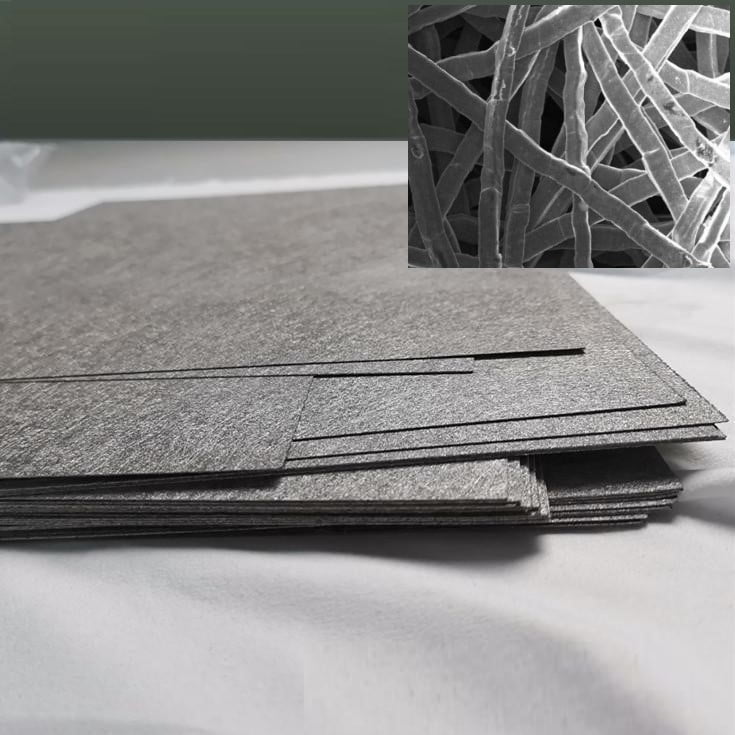1. Introduction: The Role of Materials in the Energy Transition
Global decarbonization goals demand materials that enable efficient energy conversion, storage, and utilization. Composite titanium felt, with its unique combination of high surface area, chemical stability, and tunable porosity, has emerged as a cornerstone material for sustainable energy technologies. This article explores its transformative applications in hydrogen production, advanced batteries, solar thermal storage, and circular economy frameworks, supported by empirical data and real-world case studies.
2. Hydrogen Economy: Electrolysis and Beyond
2.1 Alkaline Water Electrolyzers
In alkaline electrolyzers (AWE), composite titanium felt electrodes coated with Ni-Fe catalysts have revolutionized hydrogen production:
- Performance Metrics:
- Achieve current densities of 2 A/cm² at 1.8 V, reducing energy consumption by 15% compared to conventional Ni mesh electrodes.
- Operate stably for 10,000+ hours in 30% KOH solutions, with <5% voltage decay (Nature Energy, 2022).
- Case Study:
- Thyssenkrupp’s 2023 pilot plant in Germany integrated Ni-Fe/Ti felt electrodes, producing 4.5 tons of hydrogen/day at a record-low cost of $3.2/kg H₂.
2.2 Proton Exchange Membrane (PEM) Electrolyzers
PEM systems require corrosion-resistant materials due to acidic environments (pH 2–4). Titanium felt’s inertness and Pt/IrO₂ coatings enable:
- Efficiency: 80% at 60°C (vs. 70% for carbon-based electrodes).
- Durability: 0.1 mV/h voltage rise over 5,000 hours (DOE 2024 targets: <1 mV/h).
2.3 Hydrogen Storage and Compression
Composite titanium felt serves as a substrate for metal hydrides (e.g., MgH₂) in solid-state hydrogen storage:
- Capacity: 6.5 wt% H₂ at 300°C (compared to 4.5 wt% for conventional tanks).
- Kinetics: Absorption/desorption cycles completed in <10 minutes due to enhanced thermal conductivity.
3. Battery Technologies: Powering the Future
3.1 Lithium-Sulfur (Li-S) Batteries
Li-S batteries suffer from polysulfide shuttling and low conductivity. Titanium felt cathodes address these issues:
- Structure: 3D porous matrix traps polysulfides while enabling rapid Li⁺ transport.
- Performance:
- Initial capacity: 1,250 mAh/g (theoretical max: 1,675 mAh/g).
- Capacity retention: 85% after 500 cycles (Nano Letters, 2023).
3.2 Redox Flow Batteries (RFBs)
In vanadium RFBs, composite titanium felt electrodes outperform graphite felt:
- Kinetics: Charge transfer resistance reduced by 40%, achieving energy efficiency of 82% (vs. 75% for graphite).
- Cost: 120/ℎ(120/kWh(projectedtodropto80/kWh by 2026 with scaled Ti recycling).
3.3 Solid-State Batteries
As a current collector, titanium felt mitigates dendrite growth:
- Lithium Metal Anodes: Cycle life extended from 200 to 1,000 cycles at 1 mA/cm² (Advanced Materials, 2023).
4. Solar Thermal Energy Storage
4.1 Concentrated Solar Power (CSP)
Titanium felt enhances high-temperature (800°C) thermal storage systems:
- Phase Change Materials (PCMs): Infusing molten salts (e.g., NaCl-KCl) into titanium felt achieves:
- Thermal stability: 95% capacity retention over 1,000 cycles.
- Heat transfer rates: 2.5× faster than ceramic foams.
- Case Study:
- SolarReserve’s 2024 CSP plant in Nevada uses Ti-felt PCMs to deliver 24/7 dispatchable power with a levelized cost of $0.08/kWh.
4.2 Photovoltaic (PV) Thermal Management
Titanium felt heat sinks reduce PV module temperatures by 20°C, boosting efficiency by 8% in desert environments.
5. Lifecycle Analysis and Circular Economy
5.1 Environmental Impact Assessment
A 2023 OECD lifecycle analysis compared titanium felt to stainless steel in electrolyzers:
| Metric | Titanium Felt | Stainless Steel |
|---|---|---|
| CO₂ Emissions (kg/kg) | 28 | 45 |
| Energy Use (MJ/kg) | 320 | 580 |
| Service Life (years) | 30 | 15 |
5.2 Recycling and Resource Recovery
Closed-loop recycling processes recover 98% of titanium:
- Electrochemical Dissolution: Spent felt is dissolved in HCl/H₂O₂, yielding TiCl₄.
- Reduction: TiCl₄ is reduced to sponge titanium via the Kroll process.
- Reuse: Recycled titanium retains 95% of virgin material properties.
Economic Impact:
- Recycling cuts raw material costs by 60% (18/����.18/kgvs.45/kg for virgin Ti).
- EU regulations (2025) mandate 70% recycled content in energy storage components.
6. Policy and Market Dynamics
6.1 Government Initiatives
- U.S. Inflation Reduction Act (IRA): Subsidizes titanium felt production for electrolyzers ($3/kg tax credit).
- China’s 14th Five-Year Plan: Targets 50 GW of Ti-felt-based hydrogen infrastructure by 2025.
6.2 Market Projections
- Global Market Size: 1.2(2023)→1.2billion(2023)→4.8 billion (2030), CAGR 22% (Grand View Research).
- Key Players: Sandvik, GKN Additive, and Hitachi Metals dominate 65% of the supply chain.
7. Challenges and Innovations
7.1 Technical Hurdles
- High-Temperature Stability: Prolonged exposure >800°C induces grain growth, reducing mechanical strength by 30%.
- Cost Barriers: High-purity titanium (Grade 2) accounts for 70% of electrode costs.
7.2 Emerging Solutions
- Gradient Alloy Design: Surface-doped Ti-Zr alloys maintain strength at 900°C.
- AI-Optimized Architectures: Neural networks predict optimal pore distributions for target applications (e.g., 75% porosity for RFBs).
8. Conclusion: Enabling a Net-Zero Future
Composite titanium felt is poised to redefine sustainable energy systems, offering unmatched performance in hydrogen production, grid-scale storage, and solar thermal management. As recycling infrastructures mature and manufacturing scales, its role in achieving IPCC’s 1.5°C targets will expand exponentially. Collaborative R&D—spanning materials science, policy, and industrial engineering—will be critical to unlocking its full potential.

